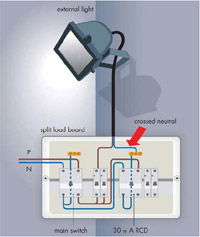In this article we discuss Residual Current Device (RCD) operation, which can occur due to electrical faults both downstream and upstream of the device. An RCD, when correctly selected and installed, can provide protection against electric shock due to indirect contact.

RCDs are also used to provide supplementary protection against direct contact and protection against thermal effects. Operation of an RCD can occur due to a downstream fault such as a crossed neutral on a split-load board, high protective current or an upstream effect such as mains-borne disturbances.
1. Indirect contact. An RCD may be used to provide protection against electric shock due to indirect contact in an installation in accordance with the requirements of Regulation 413-02-16 (for a TN system) or Regulation 413-02-20 (for a TT system) of BS 7671.
2. Direct contact. An RCD may be used to provide supplementary protection against direct contact in accordance with the requirements of Regulation 412-06 of BS 7671.
3. Incorrect application. An RCD must be correctly selected and erected for the particular application. For example, protecting an entire installation using a single highsensitivity RCD can, in many cases, lead to unwanted tripping, particularly in industrial environments where inductive loads will cause greater transient overvoltages and where longer cable runs will result in larger values of capacitance to earth.
4. No discrimination between seriesconnected RCDs. A fault downstream of two series-connected RCDs may result in operation of either device. Fig 1 illustrates two RCDs connected in series. A fault downstream of the second device will be ‘seen’ by both devices. Inconvenience may result if the upstream device operates. Discrimination, where required, must be ensured by means such as selecting a time-delayed device for the upstream device (Refer to Regulation 531-02-09).
5. Loose connections. A loose connection downstream of an RCD may cause it to operate due to transient voltages or capacitive effects. Every connection must be properly constructed (Regulation 133-01-04) of durable electrical continuity and adequate mechanical strength (526-01-01), correctly selected (526-02) enclosed (526-03) and accessible, where required (526-04).
To read the full article, please see downloadable attachment...
(article extracted from IET, Wiring Matters, Summer 06)
